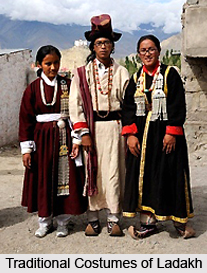 Costumes of Ladakh have a trans-Himalayan impact in it. The national dress of Ladakh is termed as `goncha` which is a practical dress for the harsh cold climate of Ladakh. Men wear is a distinctly stylish garment. It is a double-breasted calf-length coat. It is cut wide and the extra material is pulled to the back to form two pleats. It is fastened on the right shoulder and down the right side with brass buttons and loops. The edges of the stand-up collar are piped with silver brocade. The `gonchas` which are worn by poor people is made from coarse homespun woollen cloth which is a dark shade of maroon.
Costumes of Ladakh have a trans-Himalayan impact in it. The national dress of Ladakh is termed as `goncha` which is a practical dress for the harsh cold climate of Ladakh. Men wear is a distinctly stylish garment. It is a double-breasted calf-length coat. It is cut wide and the extra material is pulled to the back to form two pleats. It is fastened on the right shoulder and down the right side with brass buttons and loops. The edges of the stand-up collar are piped with silver brocade. The `gonchas` which are worn by poor people is made from coarse homespun woollen cloth which is a dark shade of maroon.
In formal occasions there are few more stylish garments like a `goncha` in black velvet, silver gleam of piping at the border and collar. The women`s `goncha` is much more elegant than that worn by men. It has a full skirt with several small pleats which is secured with a bright cummerbund. Older women tie a goatskin around the shoulders. For formal wear, the outfit is completed by wearing a hat, or by the `perak` which is the traditional head-dress of Ladakh. Silver chains and strings of coral beads complete the decoration of the head-dress. According to the Ladakhi tradition, the head dresses are the fortune of the women. The women purchase it and attach more stones to it. This is later passed from mother to daughter through generations. The head dress is much of the appearance of a cap with ear-flaps. The head dress of the women is straight and the men`s is at a casual angle.
A well-to-do Ladakhi lady has a striking and opulent appearance. The best `gonchas` are created in heavy figured Chinese silk for the females. The Ladakhi women adorn themselves with heavy strings of jewellery; baroque pearls, turquoises, coral and amber to bedeck their neck and ears. The women wear some other formal and semi formal dresses thereby maintaining new generation style. The other costume worn by women is the `chuba`. This is a more streamlined and elegant Tibetan gown. However now it`s not that much worn by the women as in earlier times. The `goncha` is sometimes complemented by the `dupatta`, the light chiffon scarf.



















